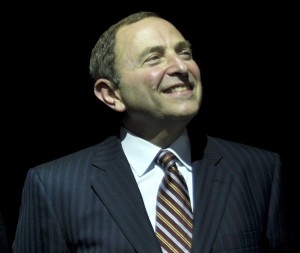A big problem is brewing on Gary Bettman’s watch: how to deal with an apparent spike in brain trauma among hockey players. The owners hired him in February of 1993 with an agenda that included two goals: one, promote “the product” of hockey to a wider audience, and two, effect a change in the game’s violent image.
Under his stewardship the NHL has gone from a $400 million business to a $3.3 billion one. Bettman has met the first goal … in part because he hasn’t met the second.

Failing to meet that second goal has had consequences. The product he sells, being a permissively violent one, is losing many of its players to central nervous system-related injuries that seem to be direct results of that violence.
Stripped down to the elements, Bettman is selling a product which presents a significant health risk to those who actually ‘create’ the product, the players.
In the 1950s the tobacco industry had a similar problem: faced with rising concerns over the carcinogenic danger of its product to consumers, the industry hired renowned PR firm Hill & Knowlton (H+K) to defend its image in the minds of the public. The tactics pioneered by H+K to defend big tobacco allowed them to make huge sums of money for as long as possible. It doesn’t matter if the product is dangerous to the public or dangerous to those who make it, the tactics remain the same and are so successful that they have been adopted by several industries. Examples include:
- Aspirin consumers and Reye’s Syndrome
- Makers of Vinyl chloride (PVC) and angiosarcoma of the liver
- Makers of chromium 6 and lung cancer
- Makers of beta-Naphthylamine and bladder cancer
- Makers of benzene and leukemia
- Aspartame consumers and cancer
- Cell phone users and brain tumors
(I’m not saying that aspartame or cell phones cause cancer; I’m only saying that both the artificial sweetener industry and the cell phone industry are right now employing the big tobacco game plan. The carcinogenic issues are in dispute; the tactics they use to keep it that way are not.)
Epidemiologist David Michaels calls it the manufacture of uncertainty. Epidemiologist Devra Davis says the point is to prolong this uncertainty so as to enrich the industry for as long as possible, or until the reality can no longer be denied.
So what are some of the plays from the big tobacco playbook and how does it appear that Gary Bettman is using them?
Express Doubt Without Denial
This takes the form of “the science isn’t quite there yet” or “we don’t have sufficient data” and it is often the first shot fired. The point is to fabricate a scientific debate, to lead the public into thinking that there are too many unresolved issues to conclusively say one thing or another.
In 1997, the NHL and the NHLPA established a concussion working group. Bettman named as its director Dr. Ruben Echemendia, former president of the National Academy of Neuropsychology. As a direct adviser to the commissioner with excellent credentials, he is a hired gun, or what Dr. Davis might call ‘the well-paid skeptic.’
Echemendia: There is evidence at this point in time to speculate about a link between repetitive blows to the head and [Chronic Traumatic Encephalopathy, or CTE]. However, we are not sure at this point in time how strong that link is or what the parameters are that would lead to CTE.
Fiddle with a Safe Alternative
In the 1960s, Kenneth Endicott, head of the US National Cancer Institute and a four-pack-a-day smoker, spent millions of taxpayer dollars trying to develop a safer cigarette because he was convinced that smoking was an impossible habit to break . His efforts amounted to nothing. Around 1970, RJ Reynolds was publicly insisting that cigarettes were safe but privately they were developing a ‘safer’ cigarette. Two decades later they brought the Premier Cigarette to market. It bombed. They lost over $1 billion.
In 2009 Mark Messier presented the league with a safer helmet. Mathieu Schneider joined the NHLPA recently, and one of his early responsibilities was to help develop a safer helmet. In 2012 Bauer introduced the RE-AKT, a so-called ‘safer’ helmet.
A safer hockey helmet promotes safer head shots. They’re still head shots, and they’re still unreliably dangerous.
Attack the Methodology
Enter the confounding variable. A familiar argument from the tobacco industry sounded like this: OK so maybe lung cancer incidence seems to be higher among smokers, how do you prove that it’s the smoking that’s causing it? Smokers are more sophisticated than non-smokers and tend to live in large metropolitan areas where they’re exposed to all manner of potentially cancer-causing agents.
Bettman: There’s no control element because you have to look at everything that went on in a person’s life before you can make a judgment as to what a brain may show when you open it up.
Establish Expert Panels
“Maybe there are two sides to every story–and maybe one of them is bought and paid for.” — David Michaels
When big tobacco needed a stable of experts to cast doubt on emerging research and invent scientific debate where there was none, they formed the Tobacco Industry Research Council and found the ideal man to do the dirty work: Clarence Cook Little, infamously featured on a cover of Time magazine smoking a pipe, and the first-ever director of the US National Cancer Institute.
The NHL has cobbled together several blue ribbon panels, with the most prominent being the one mentioned earlier, the concussion working group. In the press, director Dr. Echemendia toes the Bettman line, as do all of the league’s hired guns. Compare Echemedia’s opinion to that of an expert not on league payroll, USA Hockey’s Dr. Michael J Stuart:
Dr. Echemendia: It is very premature to draw any conclusions of any causal links between fighting and CTE. There’s just not enough evidence to support that.
Dr. Stuart: The clock is ticking. If we say we need additional long-term injury research to validate any kind of recommendation, there will be a lot of athletes who’ll suffer.
Advocate Without Endorsement
Big tobacco was careful not to overtly press the public into taking up smoking. Instead they would frame it as a personal choice, an issue of ‘this country is founded on the rights of the individual so it’s your right to smoke; don’t let anybody take away your right to do anything.’
Gary Bettman frames concussions as part of the game:
Even if it’s a legal hit, it can lead to a concussion. We play a very fast-paced, physical game in a closed environment.
At the 2011 All-Star game, Bettman said that “accidental or inadvertent” concussions were predominant:
We’ve seen players suffer concussions this season when they’ve stumbled into the boards. . . . We’ve seen players suffer concussions when struck by pucks to the head, we’ve seen players concussed when they collide with teammates.
(Good God these guys sound terrible! Can they even skate?)
The risks for Bettman et al are not minor. Their delaying tactics not only hurt their credibility, they put players from the NHL all the way down to youth hockey clubs in danger. Furthermore, the league could conceivably face a reckless endangerment lawsuit down the road if it is ever proved to the satisfaction of a jury that a player’s death from CTE, or his development of other neurological diseases such as Alzheimers or Parkinson’s Disease, are a result of playing hockey and that the league knew that this was a distinct possibility.

Several estimates suggest that fighting causes anywhere from 4-10% of concussions in the league. Personally I think fighting belongs in the league, concussion risk or not. Like New York Rangers center Brad Richards said,
You accept a fight. An elbow to the jaw is not the same as engaging in a fight. I know it looks cowardly, but you can always get out of a fight. Players can’t get out of having their bell rung.
The bell is ringing for Gary Bettman. More and more professional athletes have consented to donate their brain to Boston University’s Center for the Study of Traumatic Encephalopathy for post-mortem exam. The evidence will grow. Considering the gravity of this situation–we’re talking about peoples’ lives here–this has the potential to become his lasting legacy, as the man who borrowed big tobacco’s playbook and knowingly put profits ahead of safety.
There is only one solution: With Brendan Shanahan’s Office of Player Safety dissecting dangerous and illegal head shots so closely, the league must make hits like those delivered by Raffi Torres against Marion Hossa punishable by a lifetime ban from the NHL and a substantial fine to the player’s team, directed to the player pension fund. Keep the appeal process in place.
The best outcome imaginable is a National Hockey League devoid of the term ‘repeat offender.’
——–
Sources:
– Davis, Devra. The Secret History of the War on Cancer. Basic Books (2007).
– Michaels, David. Doubt is Their Product: How Industry’s Assault on Science Threatens Your Health. Oxford University Press (2008).
– AP. “NHL Governors discuss player safety.” 6 Dec 2011.
– Blair, Jeff. “Brad Richards: Head-shot ban would likely be accepted.” The Globe and Mail, 8 Feb 2011.
– Carrera, Katie. “Gary Bettman says concussions are increasing, most accidental.” Washington Post, 30 Jan 2011.
– Klein, Jeff Z. “Hockey Urged to Ban All Blows to Head by Concussion Panel.” The New York Times, 21 Oct 2010.
– Lapointe, Joe. “Opening day for NHL’s First Commissioner.” The New York Times, 2 Feb 1993.
– Morreale, Mike. “Campbell sheds light on head-shot debate.” NHL.com, 12 Nov 2009.
Good article and I like the comparison to the Tobacco industry. I would disagree with the comment that fighting belongs in the game. As I have posted on my blog – http://itsnotpartofthegame.blogspot.ca/ – I think fighting should be eliminated because it damages the image of hockey and takes away from a beautiful game. But you can’t ignore the injury risk. The NHL stats puts fighting related concussions at 8% of the total this past season. It sounds minor but how can a league say they are serious about safety when they allow two players to punch each other in the face. Add a game misconduct for every fight and the league can claim a fair decrease in head trauma stats next season.
You’re absolutely right, they can only keep up the facade of creating a safer league while keeping fighting around for so long before they’ll have no choice, but that’s really the crux of the article–the league knows the dangers so they’re employing the kinds of delaying tactics that put off having to make a potentially unpopular decision like taking fighting out of the league for as long as possible so as to remain as profitable as possible.